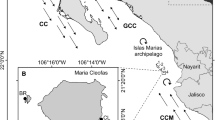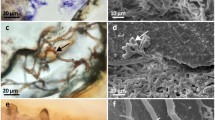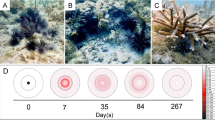Abstract
We describe Proscoloplos bondi sp. nov., a new species of orbinid polychaete found in coralline algal turf on rocky intertidal shores near Sydney, Australia. We used field sampling to describe P. bondi's patterns of spatial and temporal variation on a number of shores. P. bondi was significantly more abundant in low- than in mid-shore areas (ANOVA, P<0.05), but local populations were extremely variable in space and time. Despite extensive sampling, we did not find evidence of sexual reproduction in P. bondi, but commonly observed worms with regenerating heads and tails, which indicated the importance of asexual reproduction. We, therefore, tested the hypothesis that adult colonization contributes to its patterns of abundance. First, patches of artificial turf were placed near to and away from natural coralline turf and sampled after 2, 4 and 12 months. Generally, populations established themselves more quickly in patches of new habitat directly adjacent to coralline turf than in patches that were isolated. Second, patches of turf were deployed for 2-week periods in low- and mid-shore areas (repeated four times). Proscoloplos bondi were found significantly more often in patches in low-shore areas than in mid-shore areas and at some sites more than others (ANOVA, P<0.05), demonstrating the importance of adult colonization in determining patterns of abundance. Overall, the limited dispersal from spatially and temporally ephemeral populations of P. bondi combined with the patchiness of coralline turfs suggest that metapopulation dynamics may be important in the persistence of P. bondi on rocky shores.






Similar content being viewed by others
References
Butman CA (1987) Larval settlement of soft-sediment invertebrates: the spatial scales of pattern explained by active habitat selection and the emerging role of hydrodynamical processes. Oceanogr Mar Biol Annu Rev 25:113–165
Connell JH (1985) The consequences of variation in initial settlement vs postsettlement mortality in rocky intertidal communities. J Exp Mar Biol Ecol 93:11–45
Cummings VJ, Pridmore RD, Thrush SF, Hewitt JE (1995) Postsettlement movement by intertidal benthic macroinvertebrates: do common New-Zealand species drift in the water column? NZ J Mar Freshw Res 29:59–67
Day JH (1954) The polychaetes of Tristan da Cunha. Results Norw Sci Exped Tristan da Cunha 1937–1938 4:1–35
Day JH (1967) A monograph on the Polychaeta of Southern Africa, part II. Br Mus Nat Hist Publ 656:459–878
Dayton PK (1971) Competition, disturbance, and community organization: the provision and subsequent utilization of space in a rocky intertidal community. Ecol Monogr 41:352–389
Dewitt TH, Levinton JS (1985) Disturbance, emigration, and refugia: how the mud snail, Ilyanassa obsoleta (Say), affects the habitat distribution of an epifaunal amphipod, Microdeutopus gryllotalpa (Costa). J Exp Mar Biol Ecol 92:97–113
Gibbons MJ (1988) The impact of sediment accumulations, relative habitat complexity and elevation on rocky shore meiofauna. J Exp Mar Biol Ecol 122:225–241
Hanski I (1998) Metapopulation dynamics. Nature 396:41–49
Harrison S (1991) Local extinction in a metapopulation context: an empirical evaluation. Biol J Linn Soc 42:73–88
Hartmann-Schröder G (1962) Zur Kenntnis des Eulitorals der chilenischen Pazifikküste und der argentinischen Küste Südpatagoniens unter besonderer Berückichtigung der Polychaeten und Ostracoden, Teil 2. Polychaeten des Eulitorals. Mitt Hamb Zool Mus Inst 60:57–167
Hartmann-Schröder G (1984) Teil 10. Die Polychaeten der antiborealen Südküste Australiens (zwischen Albany im Westen und Ceduna im Osten). Mitt Hamb Zool Mus Inst 81:7–62
Hartmann-Schröder G (1986) Teil 12. Die Polychaeten der Südküste Australiens (zwischen Wallaroo im Westen und Port MacDonnell im Osten). Mitt Hamb Zool Mus Inst 83:31–70
Hartmann-Schröder G (1987) Teil 13. Die Polychaeten der antiborealen Küste von Victoria (Australien) (zwischen Warrnambool im Westen und Port Welshpool im Osten). Mitt Hamb Zool Mus Inst 84:27–66
Hartmann-Schröder G (1989) Teil 14. Die Polychaeten der antiborealen und subtropisch Küste zwischen Lakes Entrance (Victoria) im Süden und Maclean (New South Wales) im Norden. Mitt Hamb Zool Mus Inst 86:11–63
Hunt HL, Scheibling RE (1997) Role of early post-settlement mortality in recruitment of benthic marine invertebrates. Mar Ecol Prog Ser 155:269–301
Hurlbert SH (1984) Pseudoreplication and the design of ecological field experiments. Ecol Monogr 54:187–211
Kelaher BP (2001) Biodiversity of macrofaunal assemblages in coralline algal turf. PhD, University of Sydney, Sydney
Kelaher BP (2002) Influence of physical characteristics of coralline turf on associated macrofaunal assemblages. Mar Ecol Prog Ser 232:141–148
Kelaher BP, Chapman MG, Underwood AJ (2001) Spatial patterns of diverse macrofaunal assemblages in coralline turf and their association with environmental variables. J Mar Biol Assoc UK 81:1–14
Levin LA (1984) Life-history and dispersal patterns in a dense infaunal polychaete assemblage: community structure and response to disturbance. Ecology 65:1185–1200
Menge BA, Sutherland JP (1987) Community regulation: variation in disturbance, competition, and predation in relation to environmental stress and recruitment. Am Nat 130:730–757
Morrisey DJ, Howitt L, Underwood AJ, Stark JS (1992a) Spatial variation in soft-sediment benthos. Mar Ecol Prog Ser 81:197–204
Morrisey DJ, Underwood AJ, Howitt L, Stark JS (1992b) Temporal variation in soft-sediment benthos. J Exp Mar Biol Ecol 164:233–245
Nilsson PG, Levinton JS, Kurdziel JP (2000) Migration of a marine oligochaete: induction of dispersal and microhabitat choice. Mar Ecol Prog Ser 207:89–96
Peterson CH, Summerson HC, Luettich RA (1996) Response of bay scallops to spawner transplants: a test of recruitment limitation. Mar Ecol Prog Ser 132:93–107
Rouse GW (1992) Oogenesis and larval development in Micromaldane spp. (Polychaeta: Capitellida: Maldanidae). Invertebr Reprod Dev 21:215–230
Rouse GW, Fitzhugh K (1994) Broadcasting fables: is external fertilization really primitive? Sex, size and larvae in sabellid polychaetes. Zool Scr 23:271–312
Rouse GW, Pleijel F (2001) Polychaetes. Oxford University Press, London
Seed R (1996) Patterns of biodiversity in the macro-invertebrate fauna associated with mussel patches on rocky shores. J Mar Biol Assoc UK 76:203–210
Shull DH (1997) Mechanisms of infaunal polychaete dispersal and colonization in an intertidal sandflat. J Mar Res 55:153–179
Underwood AJ (1975) Comparative studies on the biology of Nerita atramentosa Reeve, Bembicium nanum (Lamarck) and Cellana tramoserica (Sowerby) (Gastropoda: Prosobranchia) in S.E. Australia. J Exp Mar Biol Ecol 19:153–172
Underwood AJ (1997) Experiments in ecology: their logical design and interpretation using analysis of variance. Cambridge University Press, Cambridge
Underwood AJ (2000) Experimental ecology of rocky intertidal habitats: what are we learning? J Exp Mar Biol Ecol 250:51–76
Underwood AJ, Chapman MG (1998) Variation in algal assemblages on wave-exposed rocky shores in New South Wales. Mar Freshw Res 49:241–254
Underwood AJ, Denley EJ (1984) Paradigms, explanations and generalizations in models for the structure of intertidal communities on rocky shores. In: Strong DR, Simberloff D, Abele LG, Thistle A (eds) Ecological communities: conceptual issues and the evidence. Princeton University Press, Princeton, N.J., pp 151–180
Young CM (1990) Larval ecology of marine invertebrates: a sesquicentennial history. Ophelia 32:1–48
Acknowledgements
This study was supported by an Australia post-graduate award to B.P.K. and an ARC QEII post-doctoral fellowship to G.W.R. We are grateful to Prof. A.J. Underwood and Dr. M.G. Chapman for helpful advice during the ecological part of this study.
Author information
Authors and Affiliations
Corresponding author
Additional information
Communicated by G.F. Humphrey, Sydney
Rights and permissions
About this article
Cite this article
Kelaher, B.P., Rouse, G.W. The role of colonization in determining spatial patterns of Proscoloplos bondi sp. nov. (Orbiniidae: Annelida) in coralline algal turf. Marine Biology 143, 909–917 (2003). https://doi.org/10.1007/s00227-003-1143-3
Received:
Accepted:
Published:
Issue Date:
DOI: https://doi.org/10.1007/s00227-003-1143-3




